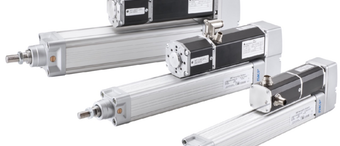Hydraulic actuators have long been the go-to choice for engineers looking to produce large forces or move heavy loads. Today, however, an increasing number of engineers are choosing electromechanical actuators over their hydraulic counterpoints.
A major reason for this switch is that electromechanical actuators tend to be smaller and lighter since they don’t require pumps, accumulators, oil tanks, and pipework. Instead they use a precision ball or roller screw to create force, drawing power from a connected electric motor. This also makes it easier to integrate electromechanical actuators into a machine’s electronic control system. Another benefit to electromechanical actuators is that, due to their design, they tend to be quieter than hydraulic actuators.
Tarek Bugaighis, president of Ewellix USA (formerly SKF Motion Technologies).Electromechanical systems can also operate at a wider range of speed and power than hydraulic equipment, and offer a higher level of positional accuracy, says Tarek Bugaighis, president of Ewellix USA (formerly SKF Motion Technologies), a supplier of actuators, pillars, ball and roller screws, and linear guides and systems. “They also work more consistently,” he adds. “The viscosity of hydraulic oils can change with time and temperature, affecting machine performance. Electromechanical systems go on working to precise tolerances and, because their moving parts are based on well-understood rolling element bearing technology, it is possible to predict their operating lifetimes under a given set of operating conditions."
Despite the apparent engineering advantages of electromechanical actuation, Bugaighis notes that a major factor impacting wider use of the technology has been its initial cost factor. “On a per-actuator basis, the initial purchase price of electric machines is certainly higher than their hydraulic counterparts,” he said. “When viewed from a total cost perspective, however, this argument rarely holds sway. Over the full lifecycle of a machine, electromechanical actuators offer sources of savings that far outweigh their higher initial cost.”
Bugaighis points to six factors as the principal reasons electromechanical systems tend to be cheaper in the long run:
- Energy efficiency. Hydraulic systems have multiple sources of energy loss from the initial conversion of electrical power into motion to drive the hydraulic pump, losses within the pump itself, fluid friction in transmission pipes and further losses within the actuator. “Overall, a hydraulic system is likely to deliver only around 44 percent of its input power to the load,” Bugaighis says. “Electromechanical systems, by contrast, lose energy only due to the limits of motor efficiency and via friction in the gearbox and actuator components. An electromechanical actuator will typically transfer 80 percent of its input power to the load. Moreover, while hydraulic pumps must run continually in most applications to ensure adequate response from the machine, the power consumption of electromechanical actuators is zero when they are not being used. This means that electric actuators can pay back their initial costs in energy savings alone in just a few months.”
- Reduced heat. The energy lost in hydraulic machines is converted to heat. In precision applications, such as plastic molding machines, this heat must be removed using chillers, further increasing overall energy demand, says Bugaighis. Because of their higher efficiency, electrically actuated machines require only around 35% of the cooling energy of a hydraulic equivalent.
- Shorter cycle times. The higher speed and improved controllability of electromechanical actuators can allow machines to run faster, increasing output, according to Bugaighis. “Take robotic spot welding in the automotive industry for example. When a Japanese car manufacturer switched to electromechanical welding tongs, this change, along with the higher speed of the new actuators, permitted an increase in throughput of 10%, equivalent to more than 100 vehicle body shells every day,” he says.
- Improved material use. Enhanced accuracy and consistency mean electrically driven machines tend to offer twice the repeatability of hydraulic alternatives, thereby reducing scrap. “Even in applications producing low precision components, savings from scrap reduction and quality improvements can outweigh the additional actuator cost in two years or less,” says Bugaighis.
- Increased uptime. Hydraulic devices rely on a network of valves, hoses, filters, and seals—a failure in any one part of the system is likely to bring the entire machine to a stop until the problem can be identified and repaired. Electric machines have fewer wearing parts, and those are all located within the ball or roller screw mechanism and gearbox. A problem with an electrical actuator can usually be addressed by quickly swapping out the affected device.
- Simplified maintenance. Having fewer reoccurring expenses, such as the need to purchase oil, filters, or seals for hydraulic systems, means that machines with electromechanical systems don’t have to be stopped for long to replace parts.
“Together, these benefits add up to savings of several tens of thousands of dollars per year for a typical production machine,” says Bugaighis. “Just under half of those savings come from areas other than energy use.”





